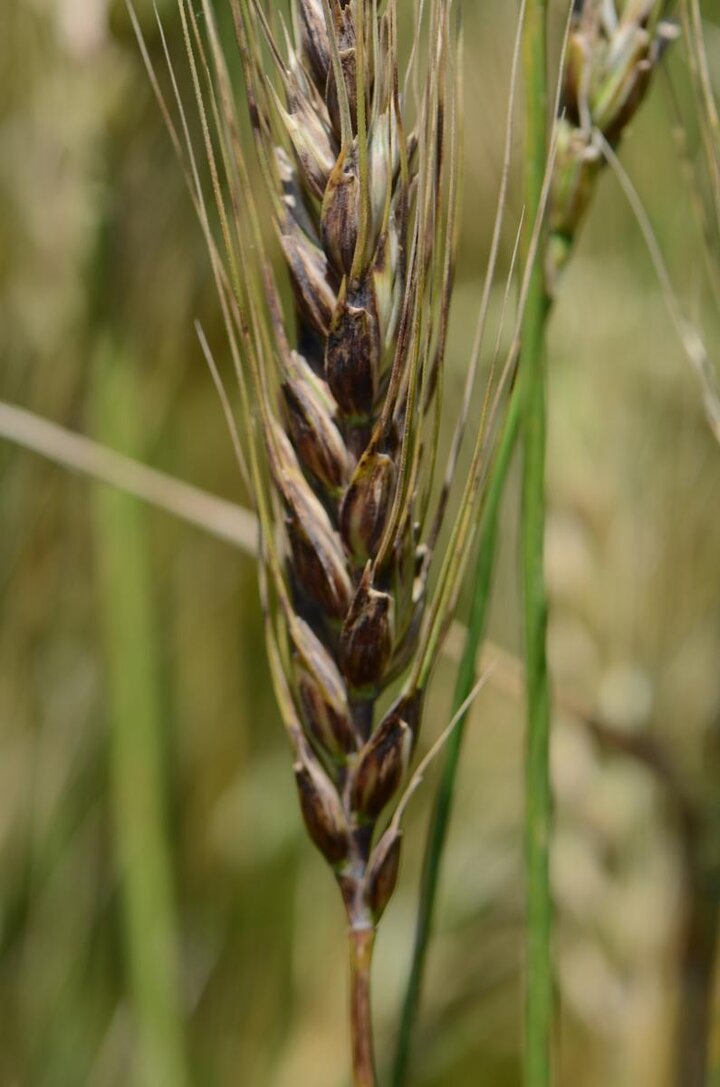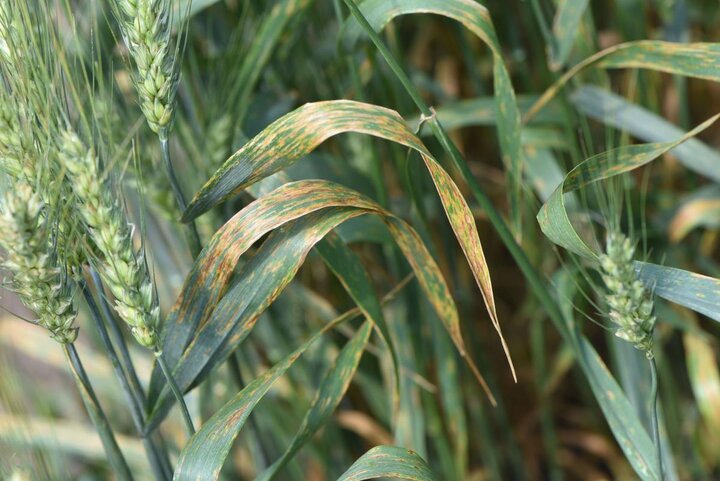

In 2018, drier than normal weather early in the growing season slowed or prevented the development of fungal diseases of wheat in April and May. Bacterial streak, also known as black chaff when it appears on wheat heads, was the predominant disease and was first observed in early June.
Other diseases observed were leaf rust, which appeared in early June, and wheat streak mosaic, which was observed in May in isolated fields in the southern Panhandle.
Because of the widespread occurrence of bacterial streak and black chaff, this wheat disease update is devoted to this disease. The following information is modified from NebGuide G1672, Black Chaff of Wheat. Photos were taken in June 2018.
Bacterial streak and black chaff is a bacterial disease of wheat common in irrigated fields or in areas with abundant rainfall during the growing season. It is also known as bacterial stripe or bacterial leaf streak. The disease also occurs on barley, oats, rye, triticale, and many grasses. It is the most important and most widely distributed bacterial disease of small grains and can cause yield losses of up to 40%.
Cause and Symptoms
Black chaff is caused by the bacterium Xanthomonas campestris pathovar (pv.) undulosa. The disease derives its name from the darkened glumes of infected plants (Figure 1). This symptom is similar to that caused by genetic melanism (darkening of tissue) and glume blotch, a fungal disease incited by Parastagonospora nodorum. Black chaff can be distinguished from other diseases by the appearance of cream to yellow bacterial ooze in the form of slime or viscous droplets produced on infected plant parts during wet or humid weather. This ooze appears light colored and scale-like when dry. Bands of necrotic and healthy tissue on awns ("barber’s pole") (Figure 1) are indicative of black chaff.
A dark brown to purple discoloration may appear on the stem below the head and above the flag leaf. On leaves, symptoms start as small water-soaked spots or streaks that turn brown after a few days. Lesions are irregularly shaped and elongate and may extend the length of the leaf blade (Figure 2). In wheat, a diffuse lime-green halo may surround lesions. Leaf symptoms give plants an overall orange cast.
Disease Cycle
The black chaff bacterium survives on and in seed, mainly in the external seed coats. Infection of the plumule (young shoot) occurs during germination and is through wounds or through stomata on the coleoptile (a sheath that protects the plumule). The bacterium invades the coleoptile and comes in contact with and infects the plumule before the first leaf emerges. The bacterium is suspected to survive on crop residue and in the soil, but this is not well documented. During the growing season, the bacterium is capable of living on the plant surface as an epiphyte without causing symptoms. Over short distances, it is spread by splashing water, plant-to-plant contact, and insects. It is spread over long distances by contaminated seed, which is the primary source of inoculum.
Bacterial exudates on infected plants and epiphytic populations on grassy weeds and volunteer cereals serve as secondary inoculum. Bacteria enter plants through stomata and wounds. Glumes and kernels are infected after head emergence. Infection and disease development are favored by wet, warm weather. The risk for disease epidemics is higher in irrigated than dryland fields.
Conditions that Favor Epidemics
- Warm temperatures
- Wet conditions (free moisture and high humidity)
- Frost damage and ice nucleation
- Injury from hail, sandblasting, or other causes
- Root rot and leaf spot diseases caused by fungi
- Insects, which may cause injury and also disseminate the bacterium
Management
The most effective management strategy for black chaff is use of certified, pathogen-free seed. Seed producers should consider testing their seed lots for black chaff before planting. Controlling volunteer cereals and grassy weeds can help to reduce primary inoculum. Irrigation management is critical in creating an environment that is less favorable for disease development and spread. Irrigation should be managed in such a way as to allow the plant canopy to dry completely between irrigations. Although highly resistant wheat cultivars are currently not available, those known to be highly susceptible to black chaff should not be planted.

